Planning a trip to Vietnam and wondering how much mobile data you’ll need? It’s a common question for international travelers, especially when exploring vibrant cities like Hanoi. This guide will help you estimate your data needs, offering insights into app usage and ways to stay connected with SIXT.VN’s travel services. Don’t let data limitations hinder your journey; discover how to travel smart and connected!
1. Understanding Your Data Needs for Travel
Is it likely you’re going to need slightly more data than you think? Yes, several factors can increase your data consumption while exploring a new destination. Let’s explore why your data needs might rise as you embark on your adventure in Vietnam:
- Unreliable or Limited WiFi: While some cafes and hotels in Hanoi offer free WiFi, the connection can be spotty or slow. You might find yourself needing mobile data more often than expected, especially when venturing off the beaten path.
- Frequent Use of Navigation Apps: Using Google Maps to navigate the bustling streets of Hanoi or find hidden gems in the Old Quarter can quickly drain your data. Live location tracking and route updates consume data as you explore.
- Background Data Consumption: Unbeknownst to many, apps syncing photos to the cloud, receiving message notifications, and performing automatic updates in the background all contribute to data usage. Unless you manually restrict these processes, they can eat into your data allowance.
- Social and Streaming Apps: Sharing your travel experiences on social media, making video calls to loved ones, or streaming entertainment during downtime can significantly increase your data consumption.
The amount of data you need depends on how you use your phone while traveling:
- Light User: 1 GB per week is sufficient for checking emails, browsing basic websites, and using messaging apps.
- Moderate User: 3-5 GB per week is suitable for moderate use of maps, music streaming, and social media.
- Heavy User: 10+ GB per week is needed for frequent video calls, streaming shows, and uploading high-resolution content.
If you can’t be forced to fit into any categories by character definition, here are some of the most common uses of data and general estimates of their consumption to help your decision:
| App Use | 1 Hour | 1 Week at 2 Hrs Per Day |
|---|---|---|
| Google Maps | 5 MB to 10 MB | 70 MB to 140 MB |
| Spotify | 40 MB to 150 MB | 560 MB to 2 GB |
| Web Browsing | 10 MB to 25 MB | 140 MB to 350 MB |
| 100 MB to 200 MB | 1 GB to 3 GB | |
| WhatsApp Calls | 300 MB to 700 MB | 4 GB to 10 GB |
| YouTube | 300 MB to 2 GB | 4 GB to 35 GB |
| Google Meet | 1.5 GB | 16 GB to 21 GB |
Table: Amount of data used by common Apps.
📌 These figures are averages. The amount of data you use will vary depending on your personal use.
Let’s take a look at each of these apps in detail below.
2. Estimating Data Usage for Common Apps
2.1. Google Meet Video Calls
How much data does a Google Meet video call use? Google Meet’s data usage varies based on video quality and call duration.
Google Meet Data Usage:
- Low-Quality Video (240p): Approximately 270 MB per hour.
- Standard-Definition Video (480p): Around 540 MB per hour.
- High-Definition Video (720p): Over 1 GB per hour.
Hosting meetings in HD or sharing screens can consume 2.25 GB per hour or more for group calls. Mobile usage averages around 500 MB per hour due to automatic optimizations based on connection strength.
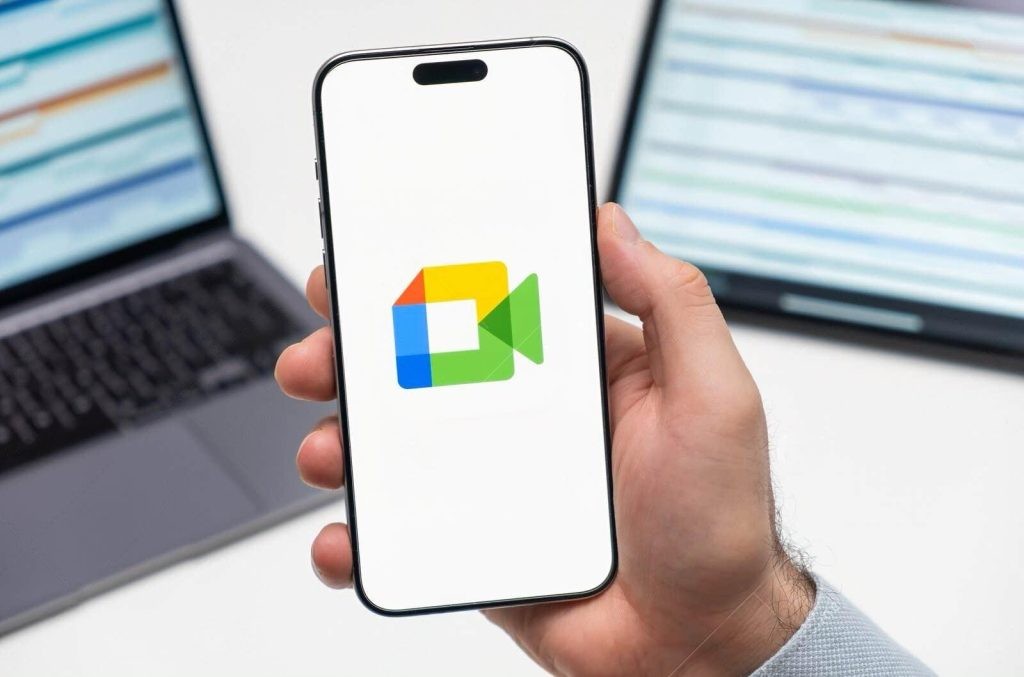 Google Meet logo on the screen of mobile phone in mans hand
Google Meet logo on the screen of mobile phone in mans hand
Google Meet loading on a mobile. Source: Freepik
2.2. Instagram Usage
How much data does Instagram use? Instagram’s data consumption depends on how you use the platform.
Instagram Data Usage:
- Normal Usage: 100 to 150 MB per hour for browsing and viewing stories.
- Heavy Usage: Up to 1 GB per hour for watching reels, videos, or uploading high-resolution content.
| 🛜 Want to save your mobile data while traveling? Check out our guide to the best places with free WiFi and stay connected! |
|---|
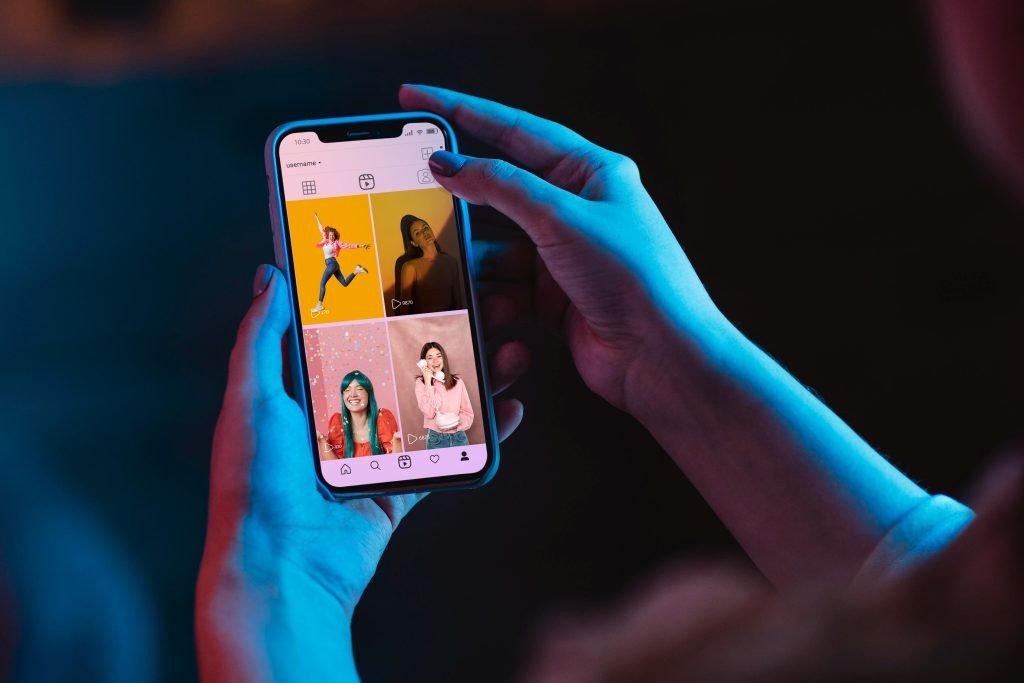 Uploading videos to Instagram reels
Uploading videos to Instagram reels
Uploading videos to Instagram reels. Source: Freepik
2.3. YouTube and Streaming Services
How much data do YouTube and other streaming services use? Streaming apps are great for downtime but consume data rapidly.
YouTube Data Usage:
- 144p: 30 to 90 MB per hour
- 480p: 480 to 660 MB per hour
- 1080p (HD): 2.5 to 4.1 GB per hour
- 4K (2160p): 5.5 to 23 GB per hour
- 8K (4320p): Up to 22.5 GB per hour
Netflix Data Usage:
- Standard Definition (SD): Up to 1 GB per hour
- High Definition (HD, 1080p): Up to 3 GB per hour
- Ultra High Definition (UHD, 4K): Up to 7 GB per hour
Here’s a quick look at data usage for other streaming services:
| Streaming Service | Standard Definition | High Definition | Ultra High Definition (4K) |
|---|---|---|---|
| Amazon Prime Video | 0.38 GB/hr | 1.4 GB/hr | 6.84 GB/hr |
| Disney+ | 0.7 GB/hr | 2.0 GB/hr | 7.7 GB/hr |
| Hulu | 0.65 GB/hr | 1.35 GB/hr | 7.2 GB/hr |
| Apple TV+ | 0.3 GB/hr | 0.7 GB/hr | 2.3 GB/hr |
| Max (HBO Max) | 0.3 GB/hr | 2.25 GB/hr | 7.7 GB/hr |
| Peacock | 0.3 GB/hr | 1.1 GB/hr | 7 GB/hr |
| ESPN+ | 0.3 GB/hr | 0.9 GB/hr | N/A |
| FuboTV | 1.2 GB/hr | 1.6 GB/hr | 7 GB/hr |
⚠️These estimates can vary based on the specific content, device settings, and network conditions. Use a Netflix Data Usage Calculator to get a clearer idea of your data use.
 Streaming videos online.
Streaming videos online.
Streaming videos online. Source: Freepik
2.4. Spotify and Apple Music
How much data does Spotify use? Music can enhance any trip.
Spotify Data Usage:
- Low Quality: 25 MB per hour
- Normal Quality: 40 MB per hour
- High Quality: 84 MB per hour
- Very High Quality: 150 MB per hour
For Apple users, here’s how much data Apple Music uses:
Apple Music Data Usage:
- High Efficiency: 30 MB per hour
- High Quality: 120 MB per hour
- Lossless: 720 MB per hour
- Hi-Res Lossless: 2.9 GB per hour
 A woman streaming music while traveling
A woman streaming music while traveling
Streaming music on mobile. Source: Unsplash
2.5. Google Maps Navigation
How much data do Google Maps use? Navigating a new city requires efficient map usage, which can impact your data.
Google Maps Data Usage:
- Turn-by-Turn Navigation: ~5 MB per hour for basic directions.
- Active Use (Zooming and Searching): 15 MB per minute for frequent route changes or satellite mode.
- Distance-Based Usage: ~90 MB per mile with continuous updates.
- Offline Map Downloads: 85 to 190 MB per city map to save data.
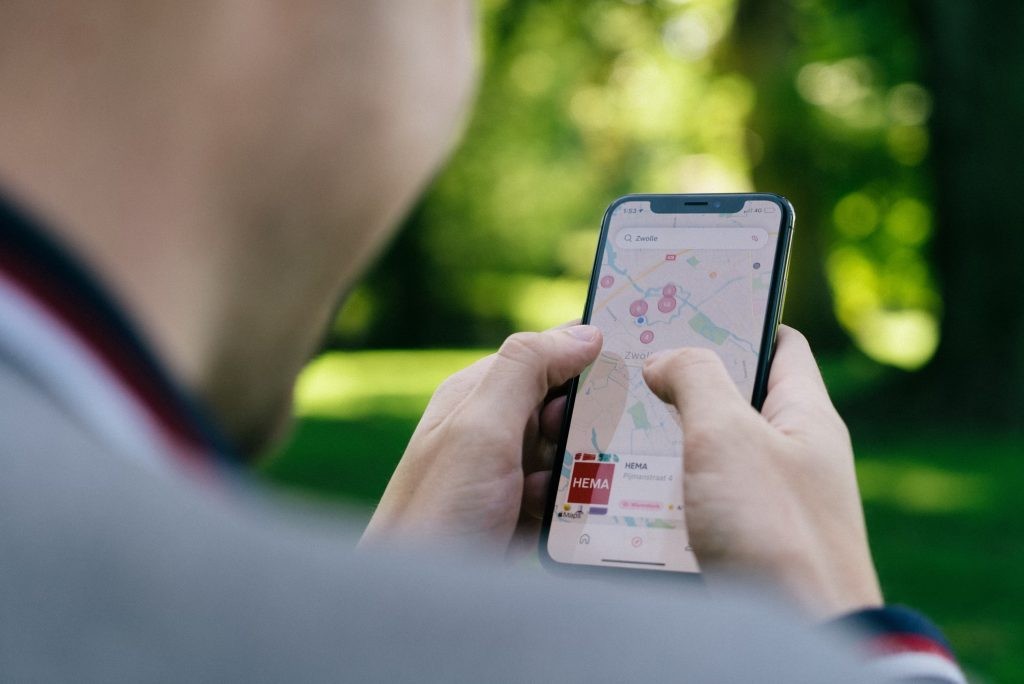 A man using maps application on mobile device
A man using maps application on mobile device
Using maps for quick search. Source: Unsplash
Now that you’ve got a sense of how much data each app and service consumes, it’s time to dive into your personal data habits. So, how do you know exactly how much data you’re using?
3. Monitoring Your Data Usage
3.1. Checking Data Usage on Your Phone
How do I know how much data I use? Monitoring your data consumption is easy on both Android and iOS devices.
On Android:
- Go to Settings.
- Tap Connections.
- Select Data Usage.
- Choose Mobile Data Usage to see your data usage for the current cycle. Scroll down to view app-specific usage.
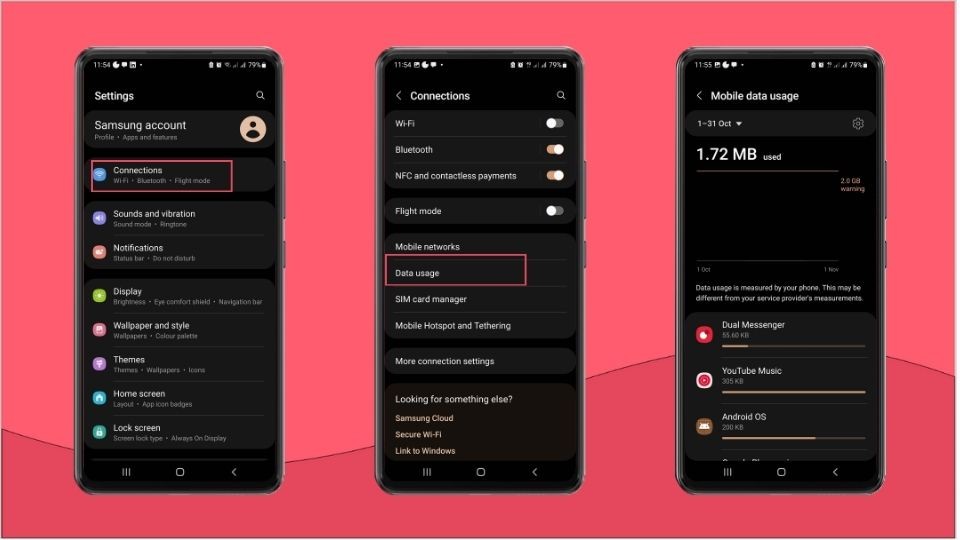 Screenshot of steps to check data usage in Android
Screenshot of steps to check data usage in Android
Easy steps to check data usage in Android
On iPhone:
- Open Settings.
- Tap Cellular or Mobile Service.
- View total usage and app-wise breakdown.
- Reset Cellular Data Statistics at the start of each billing period to track usage manually.
💡An average of one to three months of data use will give you a good idea of your general consumption.
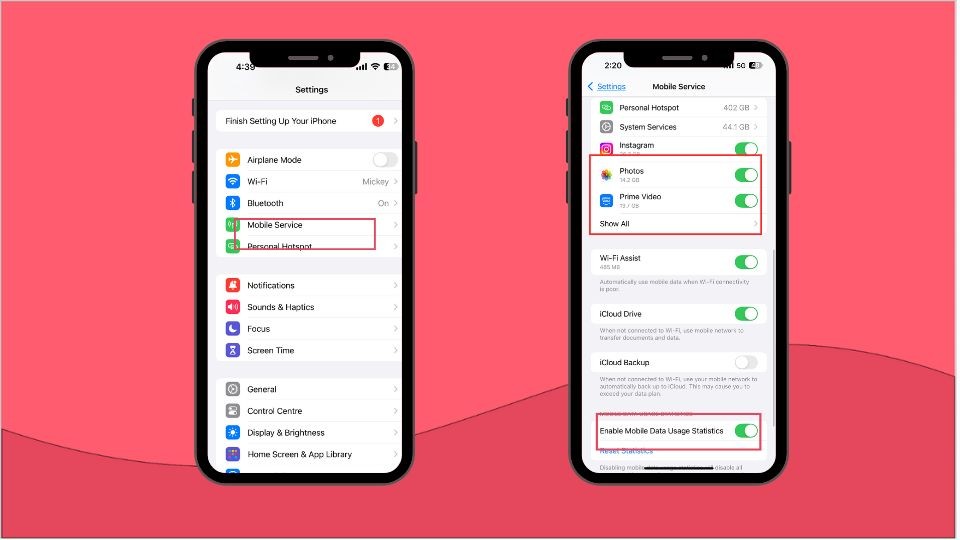 Easy steps to check app-wise data usage in iPhone
Easy steps to check app-wise data usage in iPhone
Easy steps to check app-wise data usage in iPhone
3.2. Setting Data Limits and Alerts
How to set data limits and alerts? Managing data limits helps prevent accidental overages.
On Android:
- Go to Settings.
- Tap Connections.
- Select Data usage.
- Choose Billing cycle and data warning.
- Set your billing cycle and enable Set Data Limit. Android will warn you and can stop data automatically.
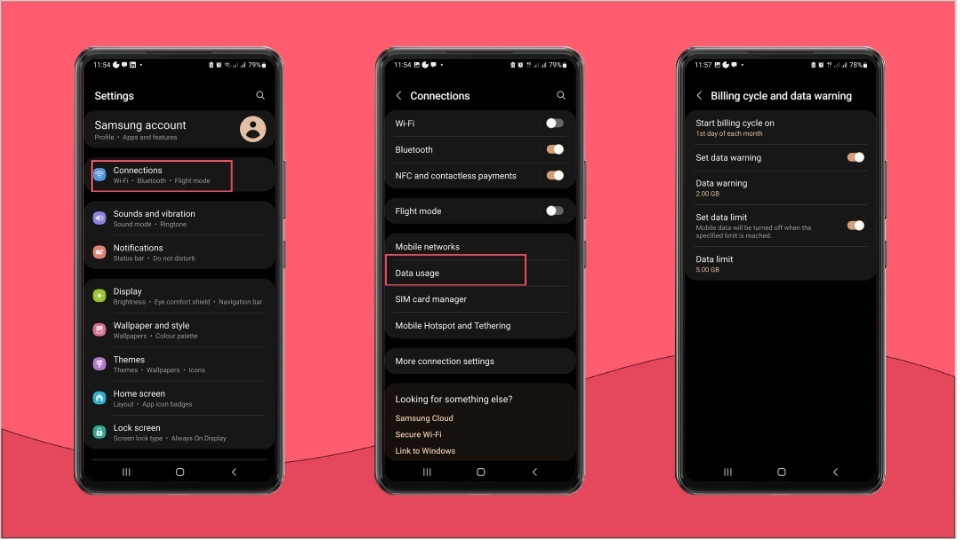 Screenshot of steps to check billing cycle in Android
Screenshot of steps to check billing cycle in Android
Easy steps to set billing cycle in Android
On iPhone:
- iPhones lack built-in data limit settings.
- Use Low Data Mode to reduce network data usage by apps.
- Go to Settings > Cellular or Mobile Service > Tap your number > Data Mode > Turn on Low Data Mode.
Next up, we’ll dive into smart ways to stretch your data further while staying connected on the go.
4. Tips to Minimize Data Usage While Traveling
Looking for ways to reduce data usage? Here are our top travel tips to minimize consumption, and maximize fun abroad:
- Data Saver Mode: Restrict background data, optimize app performance, and delay automatic synchronizations.
- Turn Off Data Roaming: Prevent accidental charges by disabling data roaming when not needed.
- Download Maps for Offline Use: Preload maps for navigation without using mobile data.
- Connect to Public WiFi: Use public networks for browsing, but avoid sensitive information on unsecured connections.
- Get an International Data Plan: Check if your carrier offers affordable plans or day passes for travel.
- Purchase a Local SIM Card: Buy one at the airport or telecom shops. Ensure your phone is unlocked.
- Use an eSIM: An eSIM is a virtual SIM card built into your phone. It’s an efficient and cost-effective way to get international coverage.
4.1. Using a Travel Data Calculator
A travel data calculator can help you estimate your mobile data usage while abroad.
By inputting information like how many days you’ll be traveling, what type of activities you’ll be doing, and what apps you may be using the calculator can help you predict your usage.
For personalized estimates, cost efficiency, and peace of mind you can visit mobile carrier or cellular providers websites to choose the right travel plan based on your data needs.
5. Unlimited Data with an eSIM: A Smarter Travel Solution
Your data usage can add up quickly — whether using Maps, posting on Instagram, or streaming your favorite TV shows. Different apps and services consume varying amounts of data, and it’s easy to use more than you expect while on the go.
But travel is all about freedom, not managing limits. If you’re looking for reliable, unlimited data without the stress, a Holafly eSIM is the perfect travel companion.
With an eSIM provider like Holafly, you get instant access to mobile networks across 200+ destinations, including unlimited data plans for entire regions like Europe or Asia.
You can purchase your eSIM from the Holafly app (available for iOS and Android), scan the QR code, and set it up in five minutes.
Holafly offers flexible plans ranging from 1 day to 90 days, so you can pick the perfect duration for your trip.
Whether you’re traveling for a weekend getaway or a month-long adventure, Holafly keeps you connected.
You can even keep your primary number active while traveling, making it easy to stay in touch with family or clients.
And with 24/7 customer support, you’re never left disconnected, no matter where your journey takes you.
| Focus on moments, not on data caps. Grab your Holafly eSIM here! |
|---|
6. SIXT.VN: Your Partner for Seamless Travel in Vietnam
Planning a trip to Vietnam can be overwhelming, but SIXT.VN is here to help. We offer a range of services tailored to make your travel experience smooth and enjoyable, including:
- Airport Transfers: Start your trip stress-free with our reliable airport transfer services.
- Hotel Bookings: Choose from a wide selection of hotels to suit your budget and preferences.
- Sightseeing Tours: Explore Hanoi and its surroundings with our expertly guided tours.
- Flight Bookings: Find the best flight deals to and from Vietnam.
SIXT.VN understands the challenges travelers face, such as language barriers and navigating unfamiliar transportation systems. We provide solutions that ensure a hassle-free experience, so you can focus on enjoying your trip.
Address: 260 Cau Giay, Hanoi, Vietnam
Hotline/WhatsApp: +84 986 244 358
Website: SIXT.VN
7. How SIXT.VN Makes Your Vietnam Trip Easier
- Personalized Travel Itineraries: SIXT.VN creates customized itineraries based on your interests and schedule.
- Reliable Airport Transfers: Our punctual and safe airport transfer services ensure a smooth start to your journey.
- Wide Range of Hotel Options: We offer a variety of hotels to match your budget and location preferences.
- Expertly Guided Tours: Our tours provide insightful experiences of Hanoi and nearby attractions.
- Best Flight Deals: We help you find affordable and convenient flight options.
By choosing SIXT.VN, you gain access to convenient, reliable, and supportive travel services, making your trip to Vietnam unforgettable.
8. Why Choose SIXT.VN for Your Vietnam Adventure?
- Convenience: Easy booking and comprehensive travel services.
- Reliability: Trusted and dependable transportation and accommodations.
- Support: Dedicated customer service to assist you throughout your trip.
Let SIXT.VN handle the details, so you can immerse yourself in the beauty and culture of Vietnam.
9. Real-World Scenarios and Data Recommendations
To give you a clearer picture, here are a few scenarios:
- The Casual Explorer: Spending a week in Hanoi, using Google Maps occasionally, checking emails, and posting some photos on social media. Recommended Data: 3-5 GB.
- The Social Media Enthusiast: Traveling for two weeks, heavily using Instagram, streaming music, and making frequent video calls. Recommended Data: 15-20 GB.
- The Business Traveler: On a 5-day business trip, using Google Meet for several hours daily, checking emails, and browsing the web. Recommended Data: 10-15 GB.
- The Family Vacationer: Traveling with family for 10 days, streaming movies for the kids, using navigation apps, and sharing photos. Recommended Data: 20+ GB.
10. Frequently Asked Questions (FAQs)
10.1. How much data does it take to use Google Maps for an hour?
Google Maps typically uses about 5 MB per hour for turn-by-turn navigation, but active use with zooming and searching can increase this to 15 MB per minute.
10.2. Is 5 GB of data enough for a week of travel?
5 GB is generally enough for a moderate user who checks emails, uses maps, and occasionally streams music or uses social media.
10.3. How can I reduce my data usage while traveling?
Enable data saver mode, download maps for offline use, connect to public WiFi when available, and turn off data roaming when not needed.
10.4. What is an eSIM, and how does it work?
An eSIM is a virtual SIM card embedded in your phone, allowing you to switch carriers without a physical SIM. It provides a convenient way to access international data plans.
10.5. Can I use my regular SIM card in Vietnam?
Yes, but you may incur high roaming charges. It’s usually more cost-effective to get a local SIM card or use an eSIM.
10.6. How much data does streaming a movie use?
Streaming a movie on Netflix can use up to 1 GB per hour in Standard Definition, 3 GB per hour in High Definition, and 7 GB per hour in Ultra High Definition.
10.7. What are the best data plans for travel to Vietnam?
Options include international data plans from your home carrier, local SIM cards, and eSIMs. Research and compare prices and data allowances to find the best fit.
10.8. How do I check my data balance on my phone?
On Android, go to Settings > Connections > Data Usage. On iPhone, go to Settings > Cellular or Mobile Data.
10.9. Is it better to use WiFi or mobile data when traveling?
Using WiFi is generally cheaper, but mobile data provides more flexibility and reliability, especially in areas with poor WiFi coverage.
10.10. How much data does a video call use?
A video call on WhatsApp can use 300 MB to 700 MB per hour, while Google Meet can use from 270 MB to 1.5 GB per hour, depending on video quality.
9. Real-World Scenarios and Data Recommendations
To give you a clearer picture, here are a few scenarios:
- The Casual Explorer: Spending a week in Hanoi, using Google Maps occasionally, checking emails, and posting some photos on social media. Recommended Data: 3-5 GB.
- The Social Media Enthusiast: Traveling for two weeks, heavily using Instagram, streaming music, and making frequent video calls. Recommended Data: 15-20 GB.
- The Business Traveler: On a 5-day business trip, using Google Meet for several hours daily, checking emails, and browsing the web. Recommended Data: 10-15 GB.
- The Family Vacationer: Traveling with family for 10 days, streaming movies for the kids, using navigation apps, and sharing photos. Recommended Data: 20+ GB.
Conclusion: Stay Connected with Confidence
Estimating your data needs for travel is essential for a smooth and enjoyable trip. By understanding how different apps consume data and utilizing data-saving tips, you can stay connected without breaking the bank. Whether you choose an international data plan, a local SIM card, or an eSIM, SIXT.VN is here to support your travel needs in Vietnam. Contact us today to learn more about our services and plan your perfect adventure!



